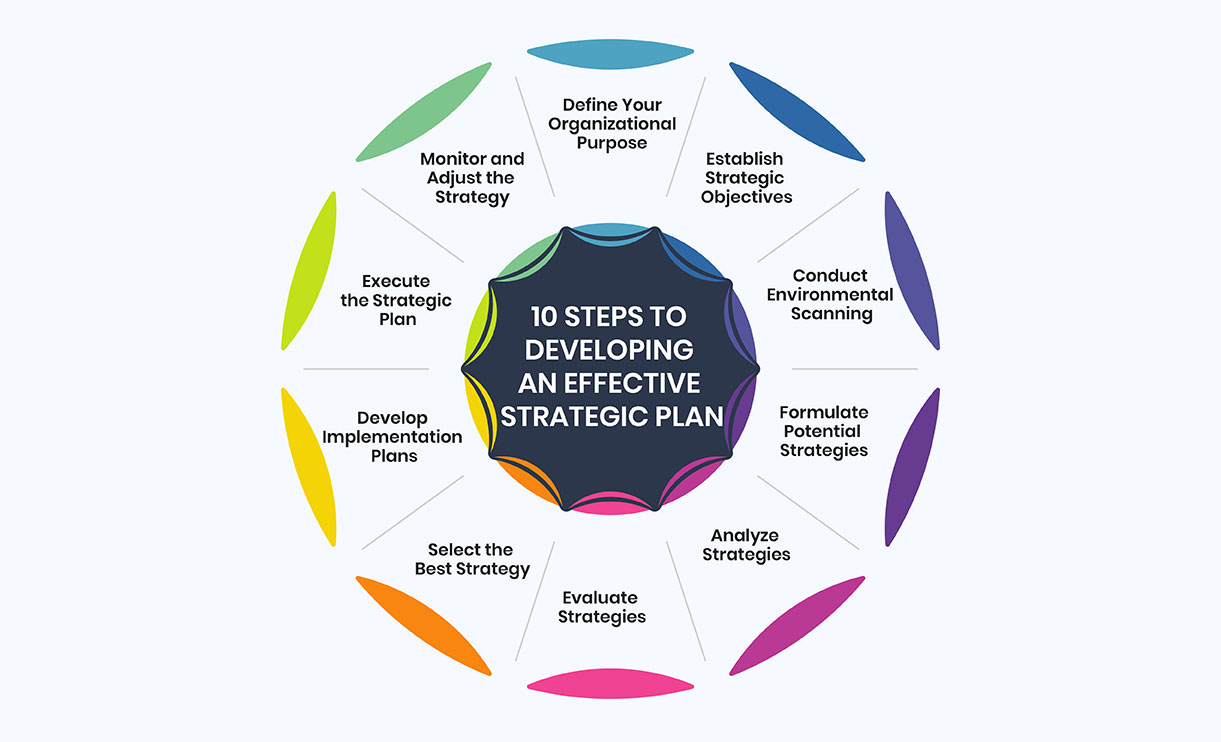Mastering Strategy Formulation: A Comprehensive Guide to Developing а Strategic Plan
 August 07, 2024
August 07, 2024
Strategy formulation is at the heart of strategic management, setting the stage for business success. It articulates how an organization intends to achieve its objectives and respond to competitive dynamics. The process is vital in the ever-changing business landscape, where strategic agility can pivot a company from survival to significant growth. This comprehensive guide will explore the essence of strategy formulation, unfold the steps in developing a strategic plan, and showcase real-world examples of strategies that drove results.
What is Strategy Formulation?
Strategy formulation is the process of establishing organizational goals and selecting courses of action to fulfill desired objectives. It involves developing a long-term plan and allocating resources to achieve strategic goals. The strategy formulation process aligns a company's mission with strategic actions, ensuring every tactical move advances the overall vision.
By integrating objectives with capabilities, strategy formulation empowers businesses to navigate complex market dynamics and drive sustainable growth. This integration makes strategies both theoretically sound and practically executable, allowing adaptability to changes. This dynamic capability is critical for maintaining competitive advantage through continuous improvement.
10 Steps to Developing an Effective Strategic Plan
The following 10 steps outline a structured approach to strategy formulation:

-
1.
Define Your Organizational Purpose
Defining your organizational purpose lays the groundwork for crafting an impactful strategic plan. The primary aim is bringing clarity to what drives the organization's existence.
Mission and vision statements get to the core of encapsulating this defining purpose in a way that resonates internally and externally. The mission answers the question of why the organization does what it does by outlining its fundamental reason for being. It illuminates the primary motivation and overarching ambition.
Complementing this, the vision paints a compelling picture of the organization's aspired future positioning and impact. Together, mission and vision statements provide the compass guiding strategic choices and day-to-day decisions, galvanizing collective efforts towards shared higher goals.
-
2.
Establish Strategic Objectives
Setting strategic objectives operationalizes the organizational purpose by translating broad ambition into concrete targets. These objectives need quantifying performance benchmarks to facilitate monitoring progress. They should also be timed to fit defined strategic horizons.
Aligning objectives with the mission ensures the plan charts a course that propels the purpose forward. Objectives need balancing ambition with realism given organizational capacities and external conditions. With measurable objectives in place, success or failure implementing the strategy becomes unambiguous.
-
3.
Conduct Environmental Scanning
Environmental scanning lays the groundwork for strategy by offering a factual basis. It involves systematically gleaning insights on the prevailing landscape from various information sources. Internally, an audit assesses resource strengths and weaknesses alongside cultural and structural dynamics.
Externally, market data, economic indicators, technological shifts, regulatory changes, competition moves, and customer preferences come under the scanner. Collected scanning findings provide the evidence base strategists draw on in decision making. Regular scanning keeps the formulated strategy synchronized with a fluid reality.
-
4.
Formulate Potential Strategies
Formulating potential strategies is when creative juices start flowing. Brainstorming taps into diverse perspectives to conceive wide-ranging, out-of-the-box options connecting objectives to scanning revelations and opportunities. Ideas emerging may range from incremental improvements to radical transformations or explorations of new strategic alternatives.
Capturing all suggestions loosens inhibitions at this stage. Scanning insights add real-world reasoning later in the process. For now, thinking outside restrictive boxes pushes the boundaries of what's possible.
-
5.
Analyze Strategies
Strategy analysis subjects options to rigorous scrutiny and evaluation. Models such as SWOT dissect internal strengths and weaknesses while examining external opportunities and threats for each proposal. This peels away layers to uncover what really drives each strategy's viability and pitfalls.
Quantitative metrics complement qualitative judgments, comparing strategic fit and risks involved for goals. Sensitivity analyses also simulate flexible scenarios to identify strategy robustness. Such analyses inject much-needed objectivity at a point when bias can cloud choices.
-
6.
Evaluate Strategies
Strategy evaluation applies further logic and reasoning to narrow choices. Feasibility weighs practical execution aspects against constraints. Acceptability considers impacts on mission and values alignment with stakeholder aspirations. Suitability examines how well a strategy maximizes resource utilization towards objectives.
Ranking options based on weighted criteria lets the most meritorious ascend. Evaluation introduces discipline, cutting through impressions to the core of what makes a strategy good or not in implementing circumstances.
-
7.
Select the Best Strategy
Selecting the best strategy requires ultimately opting for a prime option based on its relative strengths. Rather than rushing consensus, structured debate ensures thorough vetting. The preferred strategy demonstrates clearest fitness to purpose based on prior progressive analyses. It capitalizes best on emerging drivers in the scanning environment.
With proven robustness, feasibility, and acceptability, it secures backing as one optimally geared to propel objectives. Concurrence on this strategic choice unites efforts towards a shared direction.
-
8.
Develop Implementation Plans
Developing implementation plans concretizes the chosen strategy into action. Specific tasks emerge with clear responsibilities, timelines, and dependencies delineated. Plans convert lofty ambitions into granular workstreams and milestone markers. Resources like people, technology, partnerships and budgets align in optimized coordination.
Monitoring systems and reporting routines put performance tracking infrastructure in place. Risk mitigation likewise receives due consideration to avoid disruption. Completeness in planning boosts execution assurance and impact.
-
9.
Execute the Strategic Plan
Executing the strategic plan is where rubber hits the road. Rolling out involves cascading plans to the front lines and driving adoption across functions. Daily operations refocus to serve strategic imperatives. Leadership sets the tone, while change management supports behavioral transition.
Early successes create positive momentum, while course corrections address issues promptly. Continuous communication reinforces understanding and buy-in at all levels as progress vindicates initial choices through tangible results.
-
10.
Monitor and Adjust the Strategy
Monitoring and adjustment closes the loop by securing strategic agility. Regular reviews compare performance to objectives using leading and lagging indicators. Successes deserve recognition while deviations spur remedial action. Environmental scans stay vigilant for disruptions requiring strategy revival.
Feedback and fresh thinking re-examine strategic fit amid shifting contexts. Whereas rigidity leads to ruin, adaptation wins in complex environments. Continuous learning enables calibrating strategy mid-flight, safeguarding vitality over the long haul. In this way, strategy sustains a living process of envisioning and execution.
Examples of Strategy Formulation in Action
Strategy formulation allows companies to systematically develop roadmaps to achieve their goals and capitalize on opportunities. By analyzing internal strengths and weaknesses as well as external factors, businesses can craft strategies tailored to their unique situation. Let's explore examples highlighting how different companies have effectively applied strategy formulation.
-
E-commerce Company
An online retailer developed a strategy to dominate fast-moving consumer goods by optimizing its supply chain for speed and availability. Scanning found customers prioritizing convenience over prices.
The strategy aimed for industry-leading delivery times by investing in fulfillment automation and a private label brand assortment ideally suited for its supply chain capabilities and customer needs. Comprehensive implementation transformed operations to fulfill the strategy's vision.
-
Hospital Group
Facing reimbursement pressures, a network of hospitals formulated an ambulatory care strategy. Scanning revealed an aging population increasingly preferring convenient services near homes over visiting hospitals.
The strategy developed low-cost clinics and digital care programs for common, chronic, and preventive services outside hospitals. Cross-trained teams addressed multiple needs jointly. Monitoring found the strategy significantly improved accessibility, experience, and financial viability as envisioned.
Mastering the formulation process empowers businesses with a powerful framework for aligning goals, opportunities, and resources for competitive advantage. With practice, strategic planning becomes an integral management system yielding focused efforts and superior outcomes.
These real-world applications of strategy formulation principles illustrate how businesses determine goals, leverage resources and craft focused roadmaps. By analyzing all the factors, formulating measurable objectives, and developing tailored strategies, companies can navigate industry dynamics and capture opportunities. Ongoing monitoring then ensures strategies evolve as markets transform - keeping organizations constantly moving towards achieving their guiding visions.
Conclusion
In conclusion, strategy formulation requires a thorough understanding and application of a step-by-step process. With practice, organizations can develop robust strategic formulation abilities to stay relevant and achieve competitive advantage in dynamic market conditions. Adopting a rigorous yet flexible approach as demonstrated in the reference examples can empower companies to formulate strategies for enduring success.


